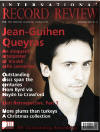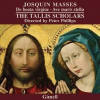Texte paru dans: / Appeared in:
*

International Record Review - (11-2011)
Pour
s'abonner / Subscription information
Gimell
CDGIM044

0755138104426
For their latest recording The Tallis Scholars return to one of the greatest composers of the high Renaissance, with compelling accounts of two Masses by Josquin Desprez that seem opposed in terms of complexity and innovation yet united in artistry and craftsmanship. United, too, in other ways, as we discover from director Peter Phillips’s booklet note: ‘With this recording we come to two of Josquin’s most intense canonic Masses, both based on plainchant themes. They make an intriguing pair.’
The Missa de Beata virgine (a late work) makes use of different chants in different modes, united only by the Marian theme of the original texts. The Missa ‘Ave maris stella’ (an earlier, ‘middle period’ work) is based on just one chant melody, Ave maris stella). The first verse of the hymn is recorded here for reference; also included is the Credo quarti toni, which in the Cambrai manuscript appears after the Missa de Beata virgine and which uses the same plainchant melody on which the ‘Creeds’ of the two Masses are based.
As with their previous Josquin recordings, The Tallis Scholars here achieve an extraordinary clarity of diction, line and texture that leans more towards explication rather than expression. That they get away with it is down to a sophisticated sense of word-painting that grows as much out of the tensions created by the complexity of the music as the meaning of the texts. This is especially true in that section of the ‘Creed’ of the Missa de Beata virgine which begins at ‘Qui cum Patre et Filio (‘Who with the Father and the Son’), which Phillips describes as ‘The most famous passage of all’ and which ‘proved to be irresistible material’ for theorists and was ‘quoted endlessly’. Here both the canon and freer melodic material are thrown into sharp relief by an intensity that offers a steely elegance rather than mere beauty. The same movement’s ‘Amen’ shares a similar, though more incandescent intensity.
Also superbly rendered are the ‘Sanctus’ of the Missa ‘Ave maris stella’, with its wonderful trio, and the ‘Agnus Dei’, which, to quote Philips again, ‘finds Josquin at his most inventive and his most inspired’. As does this recording by The Tallis Scholars.
Cliquez l'un ou l'autre
bouton pour découvrir bien d'autres critiques de CD
Click either button for many other reviews


